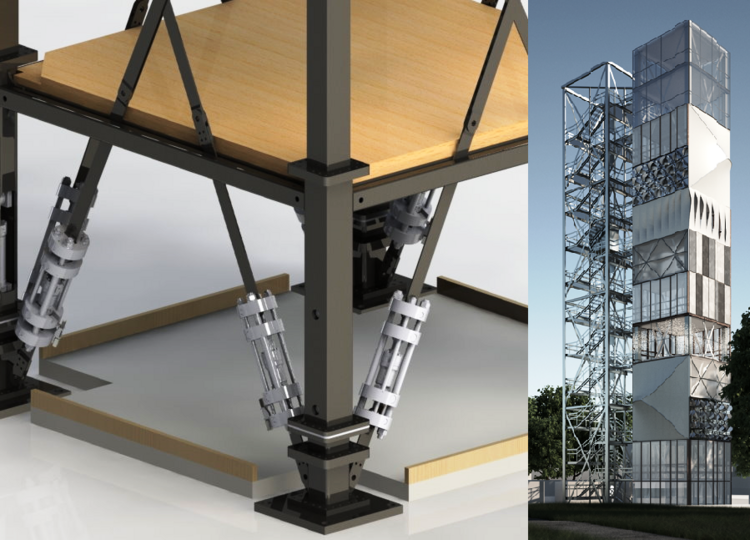Extreme lightweight construction with adaptive structural elements – economical, ecological and safe building
Abstract
The integration of actuators allows the structural cross-section of load-bearing elements to be significantly reduced without sacrificing vibration resistance. The savings potential for materials and emissions is between 30 and 50 %, and the construction concept offers completely new architectural freedom.
Background
Buildings must be designed for the conditions of their locations. If a very tall and narrow building is to be built, or even one in a region which is prone to earthquakes, a high amount of materials or additional structural elements have been necessary until now to transfer the dynamic loads, or rather to withstand the critical load cases. This conventional method of construction conflicts increasingly with the global demand for a more efficient use of resources.
Problem
In order to guarantee the required safety of civil engineering structures for all possible load cases, passive structures are generally designed for the most likely maximum (critical) load case. During the lifetime of an average building, the maximum load case occurs only very rarely, sometimes never at all. A long-term reliable system that simultaneously becomes active when static or dynamic conditions change and thus enables a material saving construction, has not existed until now.
Solution
In a project which is supported by The German Research Foundation (DFG), a new type of concept for active, adaptive structural elements came to life at the University of Stuttgart which realizes future-oriented lightweight constructions without diminishing their safety. Actuators are integrated into the structural elements as part of the process. These active elements are integrated into the bearing structure parallel or diagonally to passive structures. In this way, stress peaks are absorbed by manipulating the load transfer behavior. An actuator assembly consists of the active actuator as well as passive components for load transmission. The actuators can be, for example, hydraulic or pneumatic systems, linear drives or piezo-active elements. Using the example of a tension-only bracing element, depending on the configuration, directly-acting tensioning actuators or indirectly-acting (using deflection elements) compression actuators can be implemented. In a passive state, the static pretension can be transmitted via the tie rods so that additional elements are also no longer required for this purpose.
Adding such assemblies in a supporting structure which is designed for purely static loads (dead weight), a lightweight construction is formed which is able to actively counterbalance dynamic load cases as well as static changes by each element exercising or dissipating tensile or compressive forces depending on the load condition. This occurs automatically through the combination with corresponding sensors and a control unit.
In this way, the amount of material and thus also the overall weight of buildings can be significantly reduced in future. This will also help reduce disposal costs. By absorbing all vibrations, the lifespan of the supporting structures can be significantly increased.
For testing and demonstration purposes for future-oriented construction, a high-rise building is currently under construction at the University of Stuttgart, in which several new systems and the adaptive structural elements are being integrated (Figure 1).
Advantages
- Continuously homogeneous stress curves using real-time control of the sensor-actuator system
- No additional elements required for pretension
- Unlimited scalability
- Significantly reduced amount of material with equal stability Lightweight constructions with a saving of resources of approx. 30-50 % by avoiding oversizing
Fields of application
The described active structural elements are particularly suitable for environmentally friendly lightweight structures, very tall buildings or buildings in areas with dynamic load cases such as earthquakes, strong gusts of winds etc.
Publications and references
Publications on the opening of the Demonstrator Building:
Project page of International Building Exhibition 2027 Stadt Region Stuttgart: Adaptives Demonstrator-Hochhaus – Adaptive Demonstrator High-Rise Building: https://www.iba27.de/en/projekt/adaptives-demonstrator-hochhaus-adaptive- demonstrator-high-rise-building/
Website of the University of Stuttgart’s special research field 1244 on the demonstrator high-rise building: https://www.sfb1244.uni-stuttgart.de/en/demonstrator
Publications of the inventors on the subject:
Method for decentralized structural control:
J. L. Wagner, M. Böhm and O. Sawodny, "Decentralized structural control using Craig-Bampton reduction and local controller design," 2020 IEEE International Conference on Industrial Technology (ICIT), Buenos Aires, Argentina, 2020, pp. 41-46, doi: 10.1109/ICIT45562.2020.9067158
Study on actuator placement with respect to homogenization of loads:
M. Böhm, J. Wagner, S. Steffen, W. Sobek and O. Sawodny, "Homogenizability of Element Utilization in Adaptive Structures," 2019 IEEE 15th International Conference on Automation Science and Engineering (CASE,) Vancouver, BC, Canada, 2019, pp. 1263-1268, doi: 10.1109/COASE.2019.8843066
Methods of actuator placement for static loads and the relationship
Wagner, J., Gade, J., Heidingsfeld, M., Geiger, F., von Scheven, M., Böhm, M., Bischoff, M., & Sawodny, O. (2018). On steady-state disturbance compensability for actuator placement in adaptive structures, at - Automatisierungstechnik, 66(8), 591-603, doi: doi.org/10.1515/auto-2017-0099
Article on the demonstrator high-rise building:
Weidner, S., Kelleter, C., Sternberg, P., Haase, W., Geiger, F., Burghardt, T., Honold, C., Wagner, J., Böhm, M., Bischoff, M., Sawodny, O. and Binz, H. (2018), “The implementation of adaptive elements into an experimental high-rise building”. Steel Construction, 11: 109-117, doi: 10.1002/stco.201810019


![Fig. 2: Comparative simulation: Resulting temporal progression of absolute tensile and compressive forces of a non-actuated support (a) and (b) a support with active element after introduction of vibrations [figures: University of Stuttgart]. Fig. 2: Comparative simulation: Resulting temporal progression of absolute tensile and compressive forces of a non-actuated support (a) and (b) a support with active element after introduction of vibrations [figures: University of Stuttgart].](/fileadmin/_processed_/d/c/csm_18_032_Abb2_Vgl-Diagramm_8ebba89e94.png)